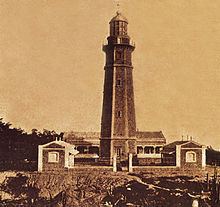Year first lit n/a (current) Opened 30 August 1892 Focal height 90 m | Deactivated n/a (first) Range 51,856 m Year first constructed 1892 | |
 | ||
Construction stone tower (first)fiberglass (current) Tower shape octagonal prism tower with balcony and lantern (first)cylindrical tower with flared top (current) Markings / pattern unpaiunted tower, white cupola Similar Torogan, Apo Reef Light, Capul Island Lighthouse, Corregidor Island Lighthouse, Cape Engaño Lighthouse | ||
Cape Melville Lighthouse is a historic lighthouse located in the island of Balabac, the southernmost point of the province of Palawan in the Philippines. It is also the southwest corner of the archipelago. The first-order light was constructed by the Spaniards to light Balabac Strait, the treacherous body of water that separates the Philippines from the neighboring country of Malaysia.
Contents
- Map of Cape Melville Lighthouse Balabac Palawan Philippines
- Current condition
- National Historical Landmark
- References
Map of Cape Melville Lighthouse, Balabac, Palawan, Philippines
The light is displayed from a 90-ft tall (27.4 m) granite tower, located on a hill 1.5 miles northwestward of the tip of Cape Melville, for a total elevation of 297 ft (90.5m) above sea level. The station was built by the Spanish Government as part of their extensive lighting plan for the archipelago. The lighthouse of Cape Melville was first lit on August 30, 1892.
Lighthouses in the Philippines are maintained by the Philippine Coast Guard.
Current condition
The Spanish lighthouse is no longer in service and a white aluminum prefabricated tower with modern solar-powered light was erected near the grounds of the old tower by the Philippine Coast Guard. Because the station is still manned, the original lights and lenses are still intact except for a central glass pane which was stolen by vandals. The tower still retains its original clockwork but is inoperative.
National Historical Landmark
The lighthouse (or Minarit) located at Brgy. Melville in Balabac Island, Palawan was declared as a National Historical Landmark by the National Historical Commission of the Philippines.
